University Research Project: Pavement Construction Materials
VerifiedAdded on 2020/05/11
|29
|5869
|120
Report
AI Summary
This research project investigates the use of recycled concrete aggregate (RCA) and polyethylene plastics (HDPE and LDPE) in pavement construction. The study examines the chemical and physical properties of these materials, including their behavior under various conditions and their potential as sustainable alternatives. The methodology includes geotechnical tests such as California Bearing Ratio (CBR), unconfined compressive strength (UCS), and repeated load triaxial (RLT) tests to evaluate the performance of RCA-HDPE and RCA-LDPE blends. The findings compare the performance of these blends with traditional quarry materials, demonstrating the potential of RCA-HDPE and RCA-LDPE as sustainable options for pavement base and sub-base layers. The report also explores the stabilization of marginal lateritic soil using fly ash and calcium carbide residue, analyzing the mechanical properties and durability of the resulting geopolymer binders. Furthermore, the study examines the influence of temperature on the performance of stabilized recycled aggregates. The research aims to promote the use of recycled materials in road construction, addressing environmental concerns and promoting sustainability in civil engineering practices.
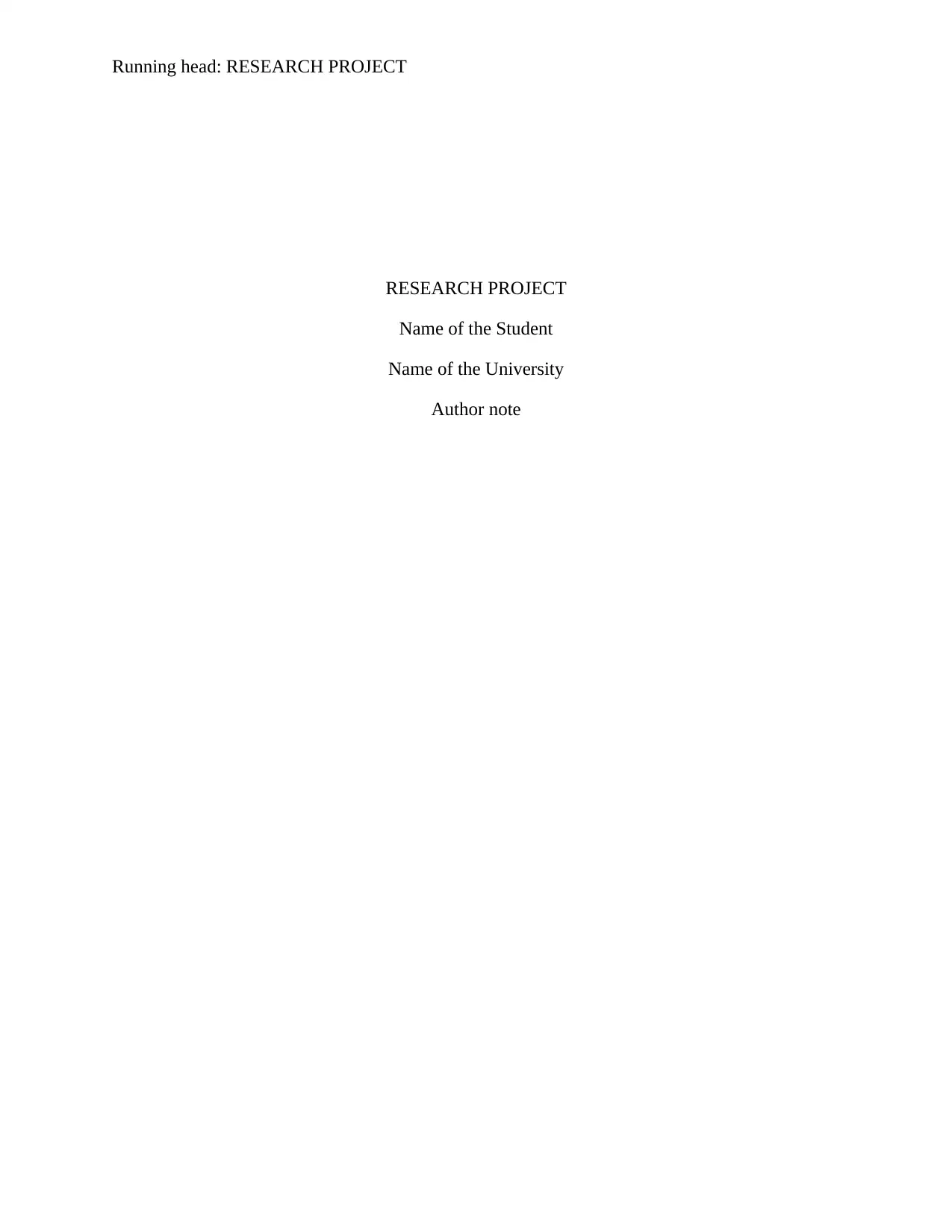
Running head: RESEARCH PROJECT
RESEARCH PROJECT
Name of the Student
Name of the University
Author note
RESEARCH PROJECT
Name of the Student
Name of the University
Author note
Paraphrase This Document
Need a fresh take? Get an instant paraphrase of this document with our AI Paraphraser
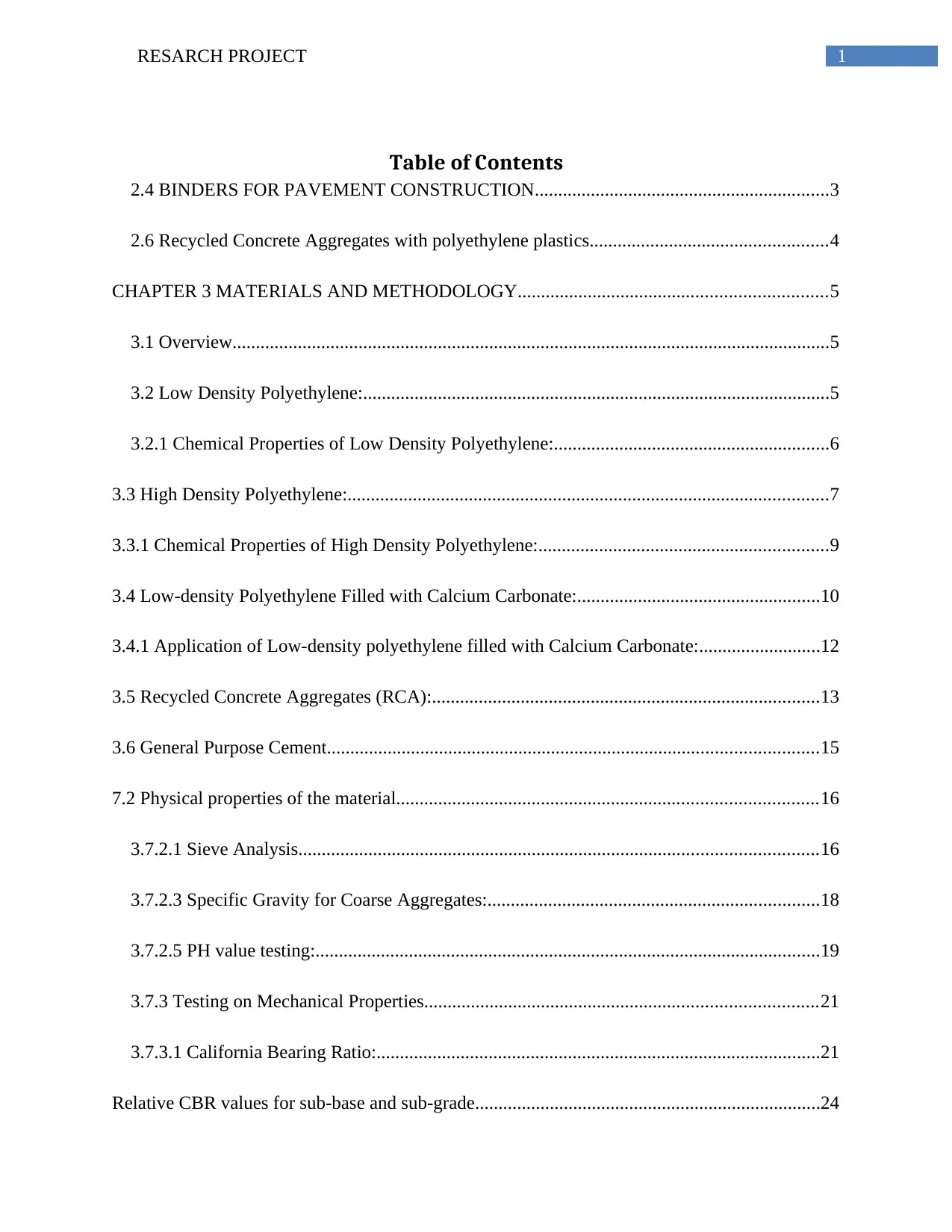
1RESARCH PROJECT
Table of Contents
2.4 BINDERS FOR PAVEMENT CONSTRUCTION...............................................................3
2.6 Recycled Concrete Aggregates with polyethylene plastics...................................................4
CHAPTER 3 MATERIALS AND METHODOLOGY..................................................................5
3.1 Overview................................................................................................................................5
3.2 Low Density Polyethylene:....................................................................................................5
3.2.1 Chemical Properties of Low Density Polyethylene:...........................................................6
3.3 High Density Polyethylene:.......................................................................................................7
3.3.1 Chemical Properties of High Density Polyethylene:..............................................................9
3.4 Low-density Polyethylene Filled with Calcium Carbonate:....................................................10
3.4.1 Application of Low-density polyethylene filled with Calcium Carbonate:..........................12
3.5 Recycled Concrete Aggregates (RCA):...................................................................................13
3.6 General Purpose Cement.........................................................................................................15
7.2 Physical properties of the material..........................................................................................16
3.7.2.1 Sieve Analysis...............................................................................................................16
3.7.2.3 Specific Gravity for Coarse Aggregates:.......................................................................18
3.7.2.5 PH value testing:............................................................................................................19
3.7.3 Testing on Mechanical Properties....................................................................................21
3.7.3.1 California Bearing Ratio:...............................................................................................21
Relative CBR values for sub-base and sub-grade..........................................................................24
Table of Contents
2.4 BINDERS FOR PAVEMENT CONSTRUCTION...............................................................3
2.6 Recycled Concrete Aggregates with polyethylene plastics...................................................4
CHAPTER 3 MATERIALS AND METHODOLOGY..................................................................5
3.1 Overview................................................................................................................................5
3.2 Low Density Polyethylene:....................................................................................................5
3.2.1 Chemical Properties of Low Density Polyethylene:...........................................................6
3.3 High Density Polyethylene:.......................................................................................................7
3.3.1 Chemical Properties of High Density Polyethylene:..............................................................9
3.4 Low-density Polyethylene Filled with Calcium Carbonate:....................................................10
3.4.1 Application of Low-density polyethylene filled with Calcium Carbonate:..........................12
3.5 Recycled Concrete Aggregates (RCA):...................................................................................13
3.6 General Purpose Cement.........................................................................................................15
7.2 Physical properties of the material..........................................................................................16
3.7.2.1 Sieve Analysis...............................................................................................................16
3.7.2.3 Specific Gravity for Coarse Aggregates:.......................................................................18
3.7.2.5 PH value testing:............................................................................................................19
3.7.3 Testing on Mechanical Properties....................................................................................21
3.7.3.1 California Bearing Ratio:...............................................................................................21
Relative CBR values for sub-base and sub-grade..........................................................................24

2RESARCH PROJECT
3.7.3.2 Repeated Loaded Tri-Axial:..............................................................................................24
3.7.3.3 Unconfined Compressive Strength:...................................................................................27
3.7.3.2 Repeated Loaded Tri-Axial:..............................................................................................24
3.7.3.3 Unconfined Compressive Strength:...................................................................................27
⊘ This is a preview!⊘
Do you want full access?
Subscribe today to unlock all pages.

Trusted by 1+ million students worldwide

3RESARCH PROJECT
2.4 BINDERS FOR PAVEMENT CONSTRUCTION
To stabilize marginal lateritic soil for building a sustainable pavement base, fly ash (FA)
and calcium carbide residue has been used. These are two waste by-products and develop geo-
polymer binders. Sodium hydroxide (NaOH concentration 10molars) and silicate solution
(Na2SiO3) of same concentration are mixed to produce the liquid alkaline activator. Images from
scanning electron microscopy (SEM) of lateritic soil–fly ash geopolymers at distinctive
prominent parts and unconfined compressive strength (UCS) are measured. The local national
authorities specifies that soaked 7 day unconfined compressive strength of lateritic soil-FA
geopolymers congregates the potency required for both heavy and light traffic pavement. The
cementitious products and early 7-day UCS boost with CCR replacement ratio and the highest
CCR replacement ratio tested is 30% at which these cementitious products are usually observed.
At 20%, this ratio providing 3-month strength can be found. This research attempts to use CCR,
which is designed for landfill traditionally, as a proponent in geopolymer binding. From
economical, environmental and engineer’s point of view, this is significant to address the
justifiable usage of CCR.
FA is a byproduct that has no footprint of carbon. It is a prospective stabilizer that
enhances the geotechnical and physical features for pavement aggregation. In this analysis, fly
ash is measured and used in different measurement in stabilizing crushed brick and recuperating
pavement for base/sub-base applications of pavement. To increase the durability and strength of
these reused materials, FA stabilization of RAP and CB has been targeted. The development of
UCS and resilient modulus of the stabilized RAP and CB aggregates under the room temperature
has been considered as well as an increased temperature of 40 degree Celsius. After that, the
result has been compared with unbound RAP and CB. It has been seen that the soil structure
2.4 BINDERS FOR PAVEMENT CONSTRUCTION
To stabilize marginal lateritic soil for building a sustainable pavement base, fly ash (FA)
and calcium carbide residue has been used. These are two waste by-products and develop geo-
polymer binders. Sodium hydroxide (NaOH concentration 10molars) and silicate solution
(Na2SiO3) of same concentration are mixed to produce the liquid alkaline activator. Images from
scanning electron microscopy (SEM) of lateritic soil–fly ash geopolymers at distinctive
prominent parts and unconfined compressive strength (UCS) are measured. The local national
authorities specifies that soaked 7 day unconfined compressive strength of lateritic soil-FA
geopolymers congregates the potency required for both heavy and light traffic pavement. The
cementitious products and early 7-day UCS boost with CCR replacement ratio and the highest
CCR replacement ratio tested is 30% at which these cementitious products are usually observed.
At 20%, this ratio providing 3-month strength can be found. This research attempts to use CCR,
which is designed for landfill traditionally, as a proponent in geopolymer binding. From
economical, environmental and engineer’s point of view, this is significant to address the
justifiable usage of CCR.
FA is a byproduct that has no footprint of carbon. It is a prospective stabilizer that
enhances the geotechnical and physical features for pavement aggregation. In this analysis, fly
ash is measured and used in different measurement in stabilizing crushed brick and recuperating
pavement for base/sub-base applications of pavement. To increase the durability and strength of
these reused materials, FA stabilization of RAP and CB has been targeted. The development of
UCS and resilient modulus of the stabilized RAP and CB aggregates under the room temperature
has been considered as well as an increased temperature of 40 degree Celsius. After that, the
result has been compared with unbound RAP and CB. It has been seen that the soil structure
Paraphrase This Document
Need a fresh take? Get an instant paraphrase of this document with our AI Paraphraser
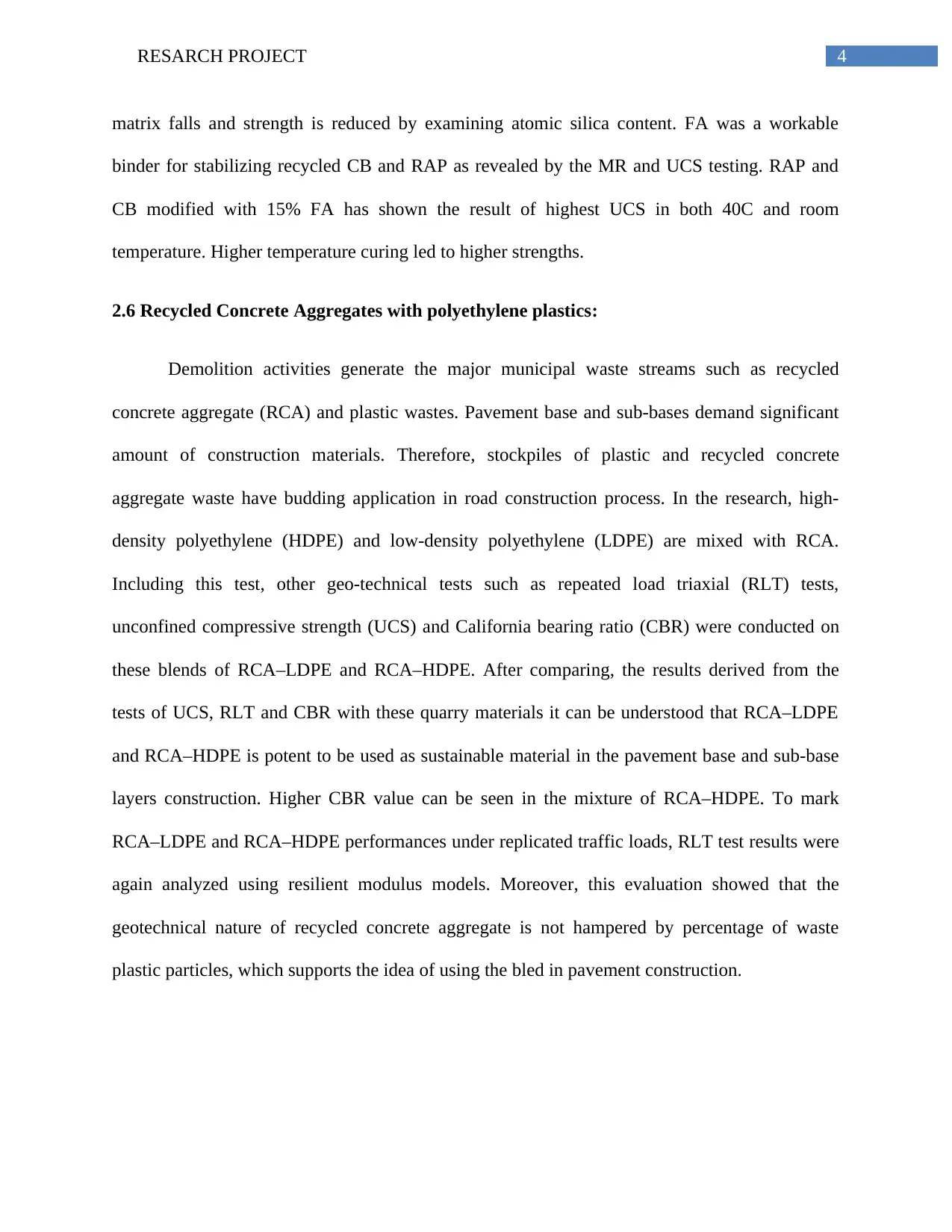
4RESARCH PROJECT
matrix falls and strength is reduced by examining atomic silica content. FA was a workable
binder for stabilizing recycled CB and RAP as revealed by the MR and UCS testing. RAP and
CB modified with 15% FA has shown the result of highest UCS in both 40C and room
temperature. Higher temperature curing led to higher strengths.
2.6 Recycled Concrete Aggregates with polyethylene plastics:
Demolition activities generate the major municipal waste streams such as recycled
concrete aggregate (RCA) and plastic wastes. Pavement base and sub-bases demand significant
amount of construction materials. Therefore, stockpiles of plastic and recycled concrete
aggregate waste have budding application in road construction process. In the research, high-
density polyethylene (HDPE) and low-density polyethylene (LDPE) are mixed with RCA.
Including this test, other geo-technical tests such as repeated load triaxial (RLT) tests,
unconfined compressive strength (UCS) and California bearing ratio (CBR) were conducted on
these blends of RCA–LDPE and RCA–HDPE. After comparing, the results derived from the
tests of UCS, RLT and CBR with these quarry materials it can be understood that RCA–LDPE
and RCA–HDPE is potent to be used as sustainable material in the pavement base and sub-base
layers construction. Higher CBR value can be seen in the mixture of RCA–HDPE. To mark
RCA–LDPE and RCA–HDPE performances under replicated traffic loads, RLT test results were
again analyzed using resilient modulus models. Moreover, this evaluation showed that the
geotechnical nature of recycled concrete aggregate is not hampered by percentage of waste
plastic particles, which supports the idea of using the bled in pavement construction.
matrix falls and strength is reduced by examining atomic silica content. FA was a workable
binder for stabilizing recycled CB and RAP as revealed by the MR and UCS testing. RAP and
CB modified with 15% FA has shown the result of highest UCS in both 40C and room
temperature. Higher temperature curing led to higher strengths.
2.6 Recycled Concrete Aggregates with polyethylene plastics:
Demolition activities generate the major municipal waste streams such as recycled
concrete aggregate (RCA) and plastic wastes. Pavement base and sub-bases demand significant
amount of construction materials. Therefore, stockpiles of plastic and recycled concrete
aggregate waste have budding application in road construction process. In the research, high-
density polyethylene (HDPE) and low-density polyethylene (LDPE) are mixed with RCA.
Including this test, other geo-technical tests such as repeated load triaxial (RLT) tests,
unconfined compressive strength (UCS) and California bearing ratio (CBR) were conducted on
these blends of RCA–LDPE and RCA–HDPE. After comparing, the results derived from the
tests of UCS, RLT and CBR with these quarry materials it can be understood that RCA–LDPE
and RCA–HDPE is potent to be used as sustainable material in the pavement base and sub-base
layers construction. Higher CBR value can be seen in the mixture of RCA–HDPE. To mark
RCA–LDPE and RCA–HDPE performances under replicated traffic loads, RLT test results were
again analyzed using resilient modulus models. Moreover, this evaluation showed that the
geotechnical nature of recycled concrete aggregate is not hampered by percentage of waste
plastic particles, which supports the idea of using the bled in pavement construction.

5RESARCH PROJECT
CHAPTER 3
MATERIALS AND METHODOLOGY
3.1 Overview
In this research, recycled concrete aggregate along with plastic particles and Cement was
used. These plastic materials were of three types, Low Density Polyethylene (LDPE), Low
Density Polyethylene and High Density Polythene (HDPE) filled with Calcium Carbonate
(LDCAL).
3.2 Low Density Polyethylene:
Low Density Polyethylene is has been produced by heating ethylene at temperatures of
100 to 300 C and high pressures (up to 3,000 bar) in the presence of free radical initiator. This
semi-crystalline thermoplastic material can be cooled easily and looks transparent only in thin
segment. Its actual color is white opaque. It feels soft with wax like touch. Its crystallinity level
is low and the polymers densities are from 0.915 - 0.940 g/cm3 largely depending on the extent
on the polymerization conditions. Both short and long chains are present. The plastic’s ease of
flow is good and easy because the branched molecules of long chain are more compact. The
material has average tensile strength though tough.
CHAPTER 3
MATERIALS AND METHODOLOGY
3.1 Overview
In this research, recycled concrete aggregate along with plastic particles and Cement was
used. These plastic materials were of three types, Low Density Polyethylene (LDPE), Low
Density Polyethylene and High Density Polythene (HDPE) filled with Calcium Carbonate
(LDCAL).
3.2 Low Density Polyethylene:
Low Density Polyethylene is has been produced by heating ethylene at temperatures of
100 to 300 C and high pressures (up to 3,000 bar) in the presence of free radical initiator. This
semi-crystalline thermoplastic material can be cooled easily and looks transparent only in thin
segment. Its actual color is white opaque. It feels soft with wax like touch. Its crystallinity level
is low and the polymers densities are from 0.915 - 0.940 g/cm3 largely depending on the extent
on the polymerization conditions. Both short and long chains are present. The plastic’s ease of
flow is good and easy because the branched molecules of long chain are more compact. The
material has average tensile strength though tough.
⊘ This is a preview!⊘
Do you want full access?
Subscribe today to unlock all pages.

Trusted by 1+ million students worldwide
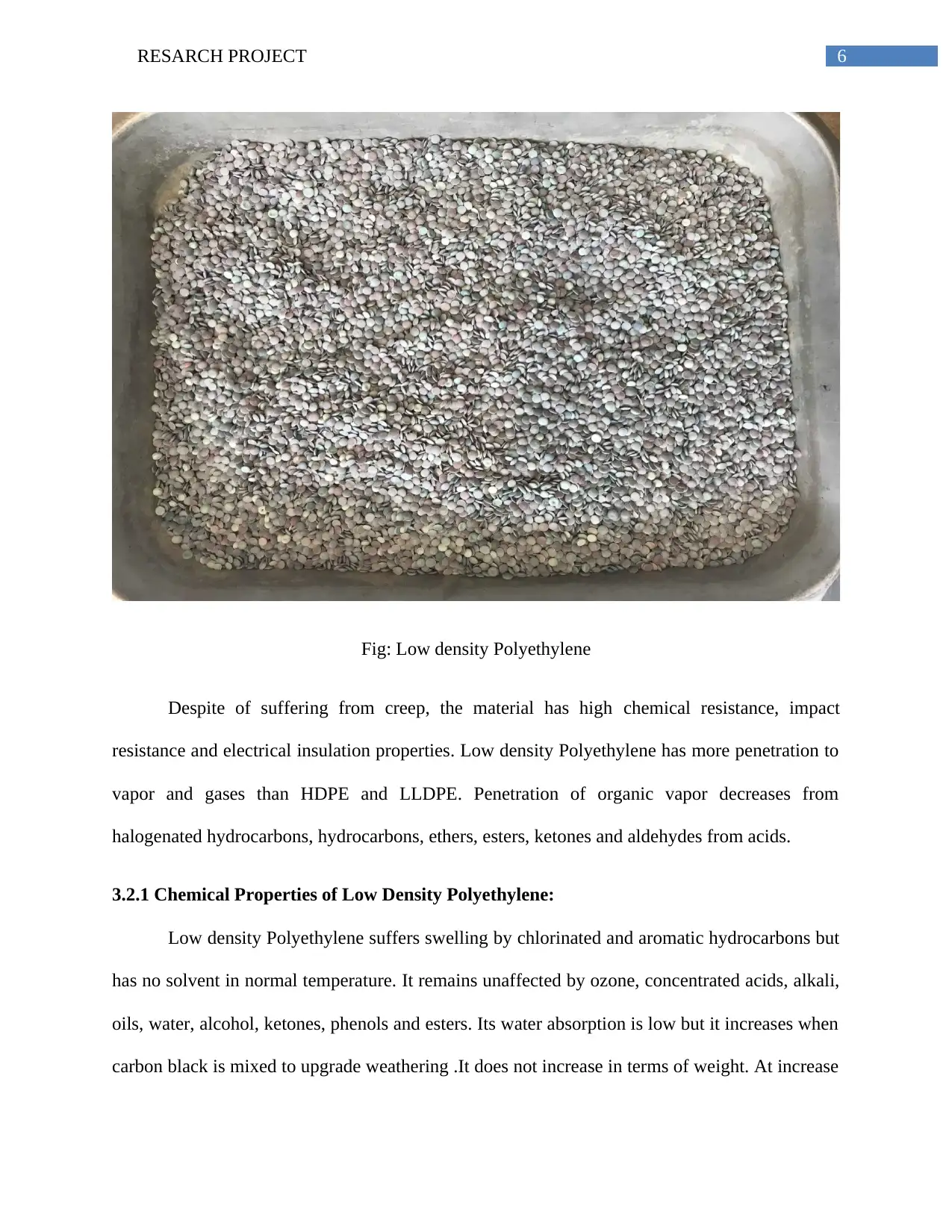
6RESARCH PROJECT
Fig: Low density Polyethylene
Despite of suffering from creep, the material has high chemical resistance, impact
resistance and electrical insulation properties. Low density Polyethylene has more penetration to
vapor and gases than HDPE and LLDPE. Penetration of organic vapor decreases from
halogenated hydrocarbons, hydrocarbons, ethers, esters, ketones and aldehydes from acids.
3.2.1 Chemical Properties of Low Density Polyethylene:
Low density Polyethylene suffers swelling by chlorinated and aromatic hydrocarbons but
has no solvent in normal temperature. It remains unaffected by ozone, concentrated acids, alkali,
oils, water, alcohol, ketones, phenols and esters. Its water absorption is low but it increases when
carbon black is mixed to upgrade weathering .It does not increase in terms of weight. At increase
Fig: Low density Polyethylene
Despite of suffering from creep, the material has high chemical resistance, impact
resistance and electrical insulation properties. Low density Polyethylene has more penetration to
vapor and gases than HDPE and LLDPE. Penetration of organic vapor decreases from
halogenated hydrocarbons, hydrocarbons, ethers, esters, ketones and aldehydes from acids.
3.2.1 Chemical Properties of Low Density Polyethylene:
Low density Polyethylene suffers swelling by chlorinated and aromatic hydrocarbons but
has no solvent in normal temperature. It remains unaffected by ozone, concentrated acids, alkali,
oils, water, alcohol, ketones, phenols and esters. Its water absorption is low but it increases when
carbon black is mixed to upgrade weathering .It does not increase in terms of weight. At increase
Paraphrase This Document
Need a fresh take? Get an instant paraphrase of this document with our AI Paraphraser
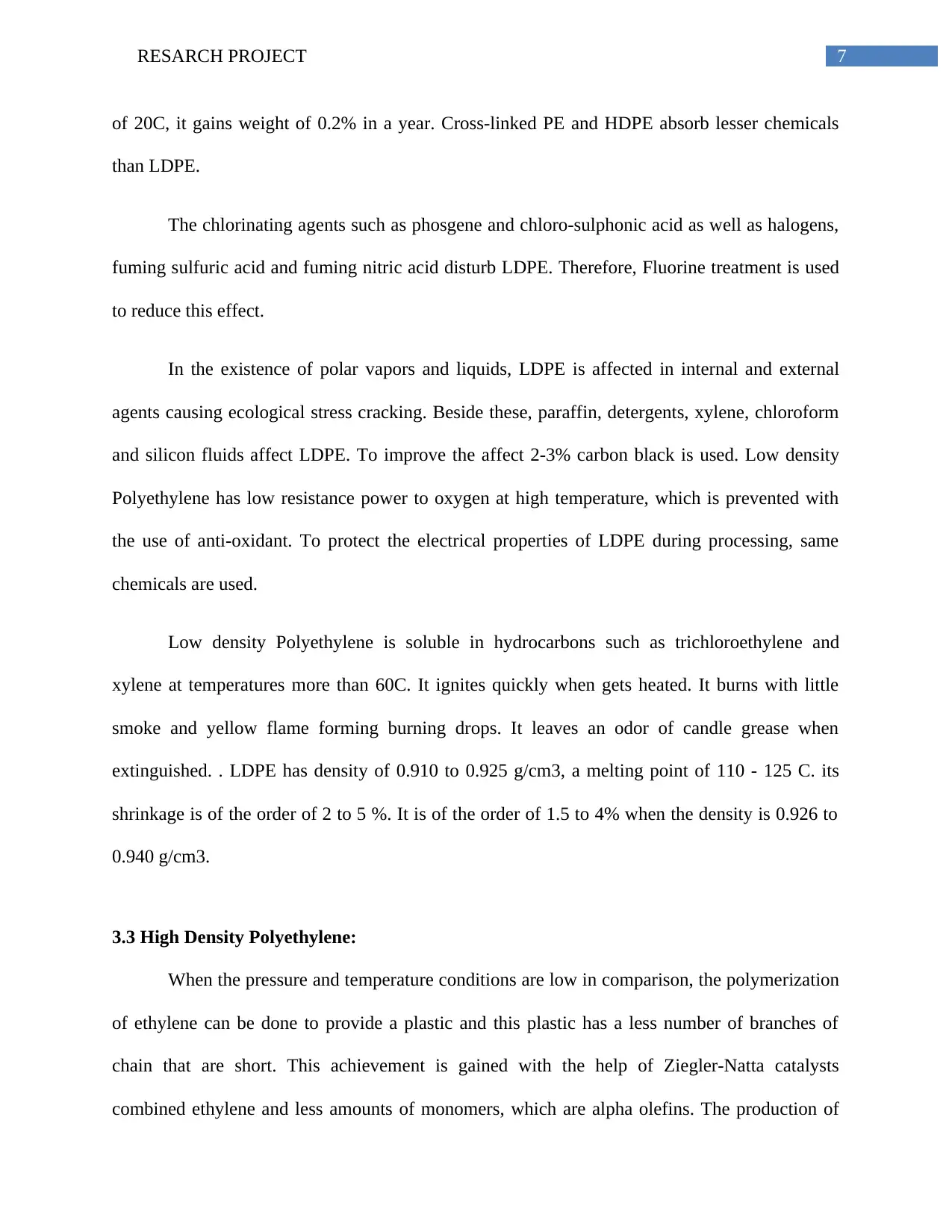
7RESARCH PROJECT
of 20C, it gains weight of 0.2% in a year. Cross-linked PE and HDPE absorb lesser chemicals
than LDPE.
The chlorinating agents such as phosgene and chloro-sulphonic acid as well as halogens,
fuming sulfuric acid and fuming nitric acid disturb LDPE. Therefore, Fluorine treatment is used
to reduce this effect.
In the existence of polar vapors and liquids, LDPE is affected in internal and external
agents causing ecological stress cracking. Beside these, paraffin, detergents, xylene, chloroform
and silicon fluids affect LDPE. To improve the affect 2-3% carbon black is used. Low density
Polyethylene has low resistance power to oxygen at high temperature, which is prevented with
the use of anti-oxidant. To protect the electrical properties of LDPE during processing, same
chemicals are used.
Low density Polyethylene is soluble in hydrocarbons such as trichloroethylene and
xylene at temperatures more than 60C. It ignites quickly when gets heated. It burns with little
smoke and yellow flame forming burning drops. It leaves an odor of candle grease when
extinguished. . LDPE has density of 0.910 to 0.925 g/cm3, a melting point of 110 - 125 C. its
shrinkage is of the order of 2 to 5 %. It is of the order of 1.5 to 4% when the density is 0.926 to
0.940 g/cm3.
3.3 High Density Polyethylene:
When the pressure and temperature conditions are low in comparison, the polymerization
of ethylene can be done to provide a plastic and this plastic has a less number of branches of
chain that are short. This achievement is gained with the help of Ziegler-Natta catalysts
combined ethylene and less amounts of monomers, which are alpha olefins. The production of
of 20C, it gains weight of 0.2% in a year. Cross-linked PE and HDPE absorb lesser chemicals
than LDPE.
The chlorinating agents such as phosgene and chloro-sulphonic acid as well as halogens,
fuming sulfuric acid and fuming nitric acid disturb LDPE. Therefore, Fluorine treatment is used
to reduce this effect.
In the existence of polar vapors and liquids, LDPE is affected in internal and external
agents causing ecological stress cracking. Beside these, paraffin, detergents, xylene, chloroform
and silicon fluids affect LDPE. To improve the affect 2-3% carbon black is used. Low density
Polyethylene has low resistance power to oxygen at high temperature, which is prevented with
the use of anti-oxidant. To protect the electrical properties of LDPE during processing, same
chemicals are used.
Low density Polyethylene is soluble in hydrocarbons such as trichloroethylene and
xylene at temperatures more than 60C. It ignites quickly when gets heated. It burns with little
smoke and yellow flame forming burning drops. It leaves an odor of candle grease when
extinguished. . LDPE has density of 0.910 to 0.925 g/cm3, a melting point of 110 - 125 C. its
shrinkage is of the order of 2 to 5 %. It is of the order of 1.5 to 4% when the density is 0.926 to
0.940 g/cm3.
3.3 High Density Polyethylene:
When the pressure and temperature conditions are low in comparison, the polymerization
of ethylene can be done to provide a plastic and this plastic has a less number of branches of
chain that are short. This achievement is gained with the help of Ziegler-Natta catalysts
combined ethylene and less amounts of monomers, which are alpha olefins. The production of
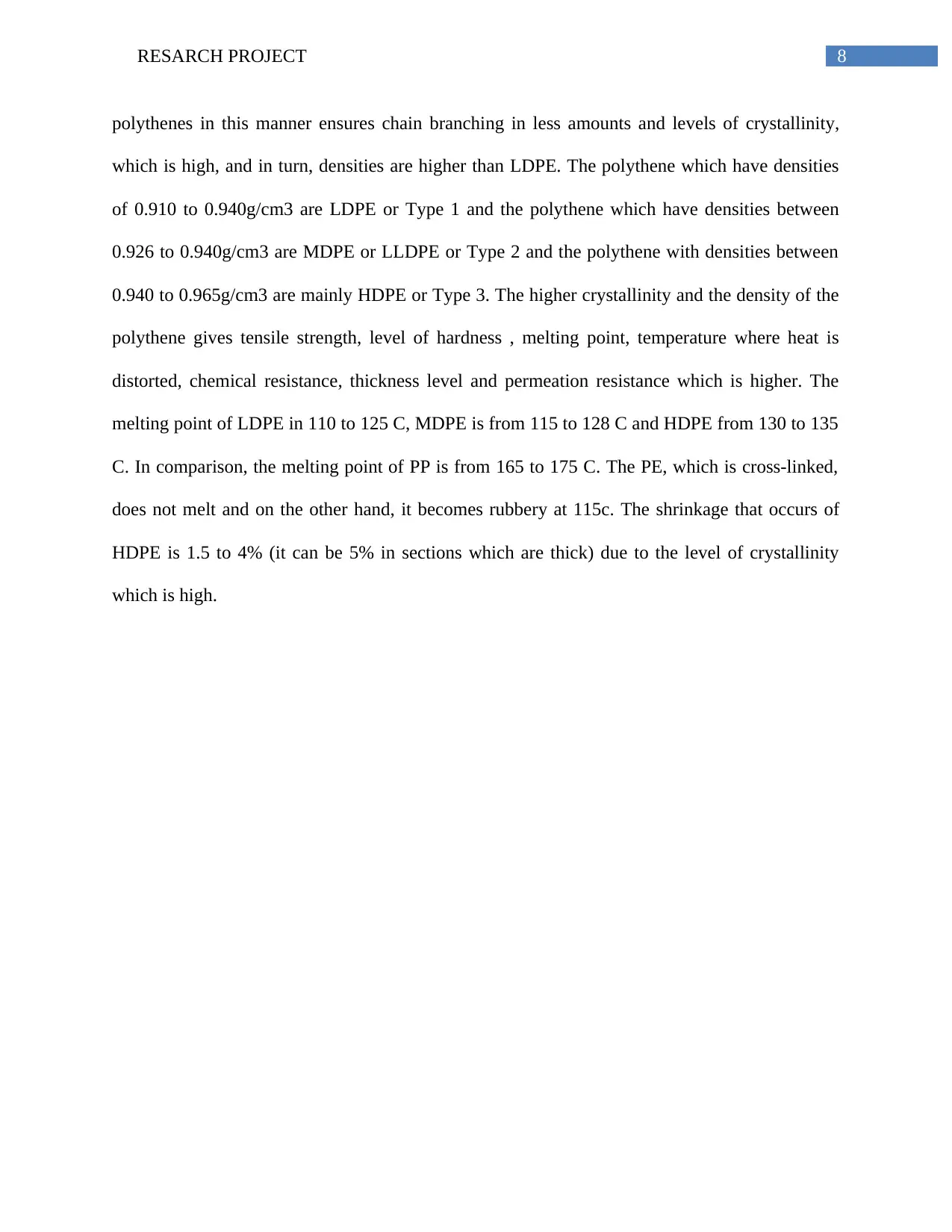
8RESARCH PROJECT
polythenes in this manner ensures chain branching in less amounts and levels of crystallinity,
which is high, and in turn, densities are higher than LDPE. The polythene which have densities
of 0.910 to 0.940g/cm3 are LDPE or Type 1 and the polythene which have densities between
0.926 to 0.940g/cm3 are MDPE or LLDPE or Type 2 and the polythene with densities between
0.940 to 0.965g/cm3 are mainly HDPE or Type 3. The higher crystallinity and the density of the
polythene gives tensile strength, level of hardness , melting point, temperature where heat is
distorted, chemical resistance, thickness level and permeation resistance which is higher. The
melting point of LDPE in 110 to 125 C, MDPE is from 115 to 128 C and HDPE from 130 to 135
C. In comparison, the melting point of PP is from 165 to 175 C. The PE, which is cross-linked,
does not melt and on the other hand, it becomes rubbery at 115c. The shrinkage that occurs of
HDPE is 1.5 to 4% (it can be 5% in sections which are thick) due to the level of crystallinity
which is high.
polythenes in this manner ensures chain branching in less amounts and levels of crystallinity,
which is high, and in turn, densities are higher than LDPE. The polythene which have densities
of 0.910 to 0.940g/cm3 are LDPE or Type 1 and the polythene which have densities between
0.926 to 0.940g/cm3 are MDPE or LLDPE or Type 2 and the polythene with densities between
0.940 to 0.965g/cm3 are mainly HDPE or Type 3. The higher crystallinity and the density of the
polythene gives tensile strength, level of hardness , melting point, temperature where heat is
distorted, chemical resistance, thickness level and permeation resistance which is higher. The
melting point of LDPE in 110 to 125 C, MDPE is from 115 to 128 C and HDPE from 130 to 135
C. In comparison, the melting point of PP is from 165 to 175 C. The PE, which is cross-linked,
does not melt and on the other hand, it becomes rubbery at 115c. The shrinkage that occurs of
HDPE is 1.5 to 4% (it can be 5% in sections which are thick) due to the level of crystallinity
which is high.
⊘ This is a preview!⊘
Do you want full access?
Subscribe today to unlock all pages.

Trusted by 1+ million students worldwide
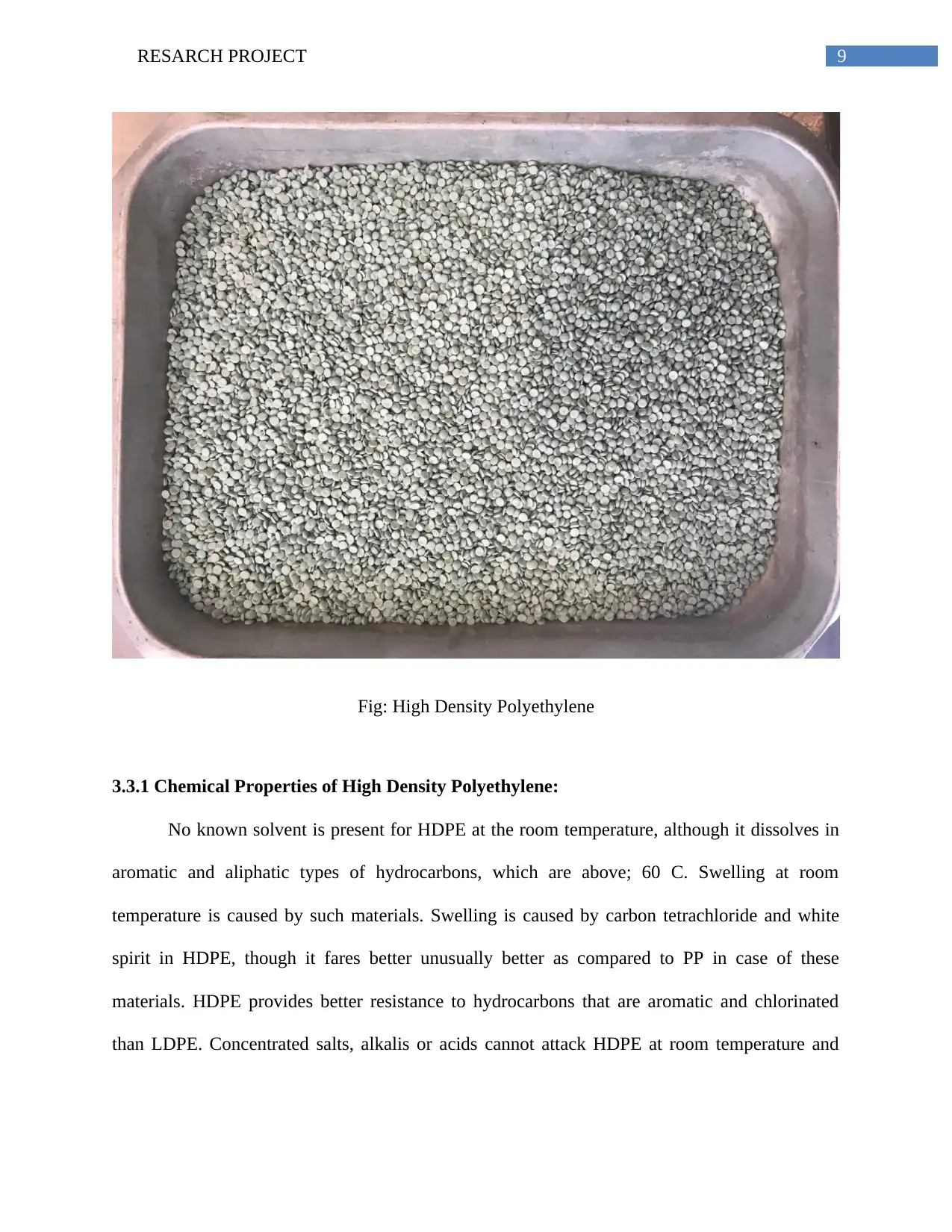
9RESARCH PROJECT
Fig: High Density Polyethylene
3.3.1 Chemical Properties of High Density Polyethylene:
No known solvent is present for HDPE at the room temperature, although it dissolves in
aromatic and aliphatic types of hydrocarbons, which are above; 60 C. Swelling at room
temperature is caused by such materials. Swelling is caused by carbon tetrachloride and white
spirit in HDPE, though it fares better unusually better as compared to PP in case of these
materials. HDPE provides better resistance to hydrocarbons that are aromatic and chlorinated
than LDPE. Concentrated salts, alkalis or acids cannot attack HDPE at room temperature and
Fig: High Density Polyethylene
3.3.1 Chemical Properties of High Density Polyethylene:
No known solvent is present for HDPE at the room temperature, although it dissolves in
aromatic and aliphatic types of hydrocarbons, which are above; 60 C. Swelling at room
temperature is caused by such materials. Swelling is caused by carbon tetrachloride and white
spirit in HDPE, though it fares better unusually better as compared to PP in case of these
materials. HDPE provides better resistance to hydrocarbons that are aromatic and chlorinated
than LDPE. Concentrated salts, alkalis or acids cannot attack HDPE at room temperature and
Paraphrase This Document
Need a fresh take? Get an instant paraphrase of this document with our AI Paraphraser
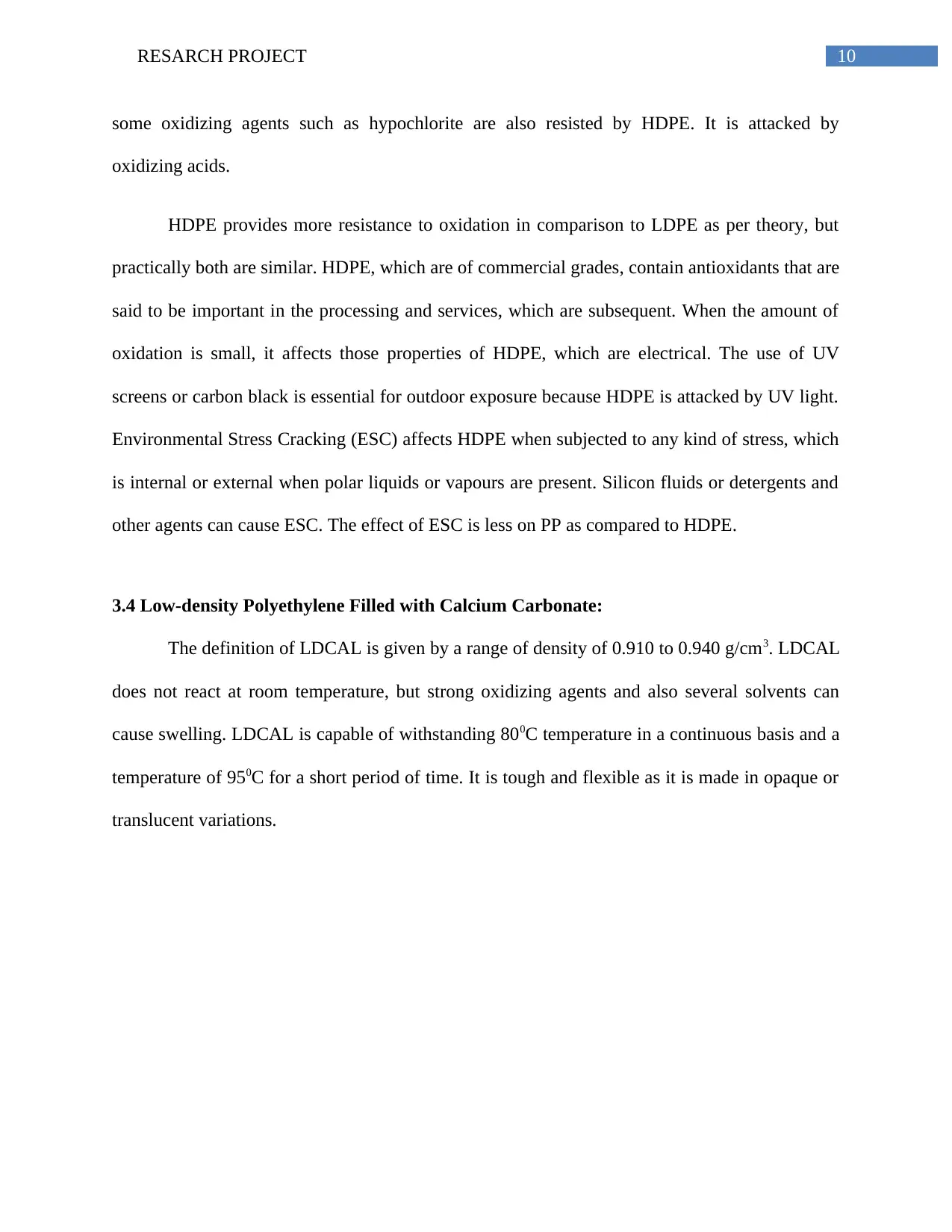
10RESARCH PROJECT
some oxidizing agents such as hypochlorite are also resisted by HDPE. It is attacked by
oxidizing acids.
HDPE provides more resistance to oxidation in comparison to LDPE as per theory, but
practically both are similar. HDPE, which are of commercial grades, contain antioxidants that are
said to be important in the processing and services, which are subsequent. When the amount of
oxidation is small, it affects those properties of HDPE, which are electrical. The use of UV
screens or carbon black is essential for outdoor exposure because HDPE is attacked by UV light.
Environmental Stress Cracking (ESC) affects HDPE when subjected to any kind of stress, which
is internal or external when polar liquids or vapours are present. Silicon fluids or detergents and
other agents can cause ESC. The effect of ESC is less on PP as compared to HDPE.
3.4 Low-density Polyethylene Filled with Calcium Carbonate:
The definition of LDCAL is given by a range of density of 0.910 to 0.940 g/cm3. LDCAL
does not react at room temperature, but strong oxidizing agents and also several solvents can
cause swelling. LDCAL is capable of withstanding 800C temperature in a continuous basis and a
temperature of 950C for a short period of time. It is tough and flexible as it is made in opaque or
translucent variations.
some oxidizing agents such as hypochlorite are also resisted by HDPE. It is attacked by
oxidizing acids.
HDPE provides more resistance to oxidation in comparison to LDPE as per theory, but
practically both are similar. HDPE, which are of commercial grades, contain antioxidants that are
said to be important in the processing and services, which are subsequent. When the amount of
oxidation is small, it affects those properties of HDPE, which are electrical. The use of UV
screens or carbon black is essential for outdoor exposure because HDPE is attacked by UV light.
Environmental Stress Cracking (ESC) affects HDPE when subjected to any kind of stress, which
is internal or external when polar liquids or vapours are present. Silicon fluids or detergents and
other agents can cause ESC. The effect of ESC is less on PP as compared to HDPE.
3.4 Low-density Polyethylene Filled with Calcium Carbonate:
The definition of LDCAL is given by a range of density of 0.910 to 0.940 g/cm3. LDCAL
does not react at room temperature, but strong oxidizing agents and also several solvents can
cause swelling. LDCAL is capable of withstanding 800C temperature in a continuous basis and a
temperature of 950C for a short period of time. It is tough and flexible as it is made in opaque or
translucent variations.

11RESARCH PROJECT
More branching (on 2% of the atoms of carbon) is present in LDCAL than that of HDPE that is
the reason it has higher intermolecular forces (instantaneous-dipole induced-dipole attraction), it
has higher tensile strength, it has higher resilience. The packing of the molecules is less tight and
crystallanity is also less for the reason of the side branches, it has a lesser density. The chemical
properties are mentioned below:
Resistance (no attack / no chemical reaction) provided to concentrated and dilute acids,
bases, alcohols and esters is excellent
Resistance (attack which is minor / low reactivity of chemical) provided to ketones,
aldehydes and vegetable oils
More branching (on 2% of the atoms of carbon) is present in LDCAL than that of HDPE that is
the reason it has higher intermolecular forces (instantaneous-dipole induced-dipole attraction), it
has higher tensile strength, it has higher resilience. The packing of the molecules is less tight and
crystallanity is also less for the reason of the side branches, it has a lesser density. The chemical
properties are mentioned below:
Resistance (no attack / no chemical reaction) provided to concentrated and dilute acids,
bases, alcohols and esters is excellent
Resistance (attack which is minor / low reactivity of chemical) provided to ketones,
aldehydes and vegetable oils
⊘ This is a preview!⊘
Do you want full access?
Subscribe today to unlock all pages.

Trusted by 1+ million students worldwide
1 out of 29
Your All-in-One AI-Powered Toolkit for Academic Success.
+13062052269
info@desklib.com
Available 24*7 on WhatsApp / Email
![[object Object]](/_next/static/media/star-bottom.7253800d.svg)
Unlock your academic potential
Copyright © 2020–2025 A2Z Services. All Rights Reserved. Developed and managed by ZUCOL.